Pros
-
Searing brightness
-
Rich color saturation
-
Beautiful design
Cons
-
Occasional LED bloom in high contrast scenes
Testing revealed that this TV does a whole lot of things right, giving you excellent contrast, searing HDR brightness, accurate colors, and a zippy, full-flavored smart platform that includes a huge range of software extras. While the new mini-LED backlight still doesn’t entirely correct for local-dimming bloom in all circumstances, the end result is an otherwise near-flawless performer.
The total package here is wholly svelte, from design to performance, especially if you want a TV that looks equally good in both bright and dark environments. The only real caveat is the price: while the QN90A is a good bit cheaper than LG's G1 OLED, it's still a major investment, though we expect that price to fall later in the year. If you can't wait, we won't blame you: this TV is the searing signature on a love letter to LED TVs.
Editor’s note: Due to COVID-19 considerations, this review leans more heavily on lab data and less on time spent watching content.
About the Samsung QN90A Neo QLED TV
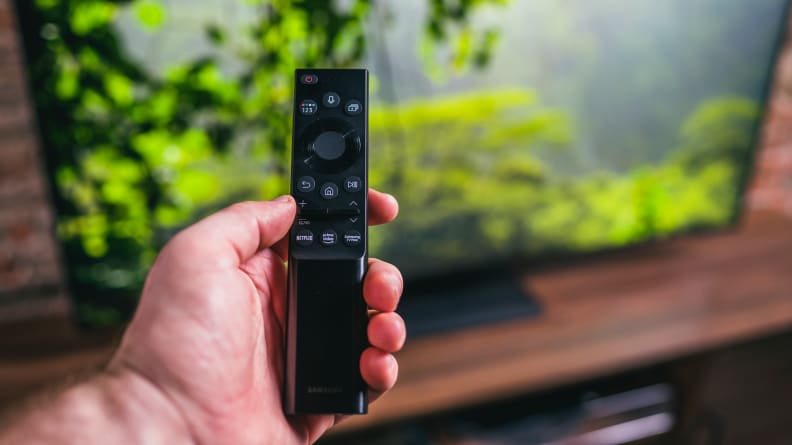
Samsung's QN90A series is available in 55-, 65-, 75-, and 85-inch sizes starting at $1,799. We reviewed a 55-inch model purchased at retail.
Samsung’s top Neo QLED TV series for 2021 is available in four screen sizes:
- 55-inch (Samsung QN55QN90A), MSRP $1,799.99
- 65-inch (Samsung QN65QN90A), MSRP $2,599.99
- 75-inch (Samsung QN75QN90A), MSRP $3,499.99
- 85-inch (Samsung QN85QN90A), MSRP $4,999.99
The QN90A is Samsung’s top-tier 4K TV series for 2021. These “Neo QLED” sets are so called because they deliver Samsung’s first-ever combination of quantum dot color and mini-LED backlights. While there may be small differences from one size to the next owing to dimming zone count, we expect the QN90A models to generally perform the same regardless of size.
For the QN90A series, here are the specs at a glance:
- Resolution: 4K (3,840 x 2,160)
- Display type: Neo QLED (quantum dot + micro-LED)
- Dimming technology: Ultimate UHD Dimming (Micro Dimming)
- HDR support: HDR10, HDR10+, HLG
- Dolby Atmos: Passthrough via eARC (no native decoding)
- eARC support: Yes
- Native refresh rate: 120 Hz
- Smart platform: Tizen Smart TV
- Color: DCI-P3 color space/10-bit chroma resolution
- Processor: Neo Quantum Processor 4K
- Variable Refresh Rate (VRR): Yes
- Auto Low-Latency Mode (ALLM): Yes
- Other features: Object Tracking Sound+, Motion Xcelerator Turbo+, Q-Symphony, SpaceFit Sound, Active Voice Amplifier, Super UltraWide GameView, GameBar, Multi View, Tap View, Samsung TV Plus, Universal View, Samsung Health
As Samsung’s top 4K Neo QLED series, the QN90A TVs show off the company’s most advanced tech and features for 2021. As far as factors like processing speed, motion enhancement, or gaming-facing extras go, only the supremely expensive 8K Neo QLED TVs can stand up to the QN90A series.
Performance Data
We test TVs in a light-controlled lab at our HQ in Cambridge, MA, but beforehand, we assemble it and run a moving test pattern on the screen for a minimum of 24 hours, which gives it time to warm up and settle into continuous operation.
The performance data below is gathered during our suite of test procedures, most of which rely on objective lab data gathered via light-measuring meters aimed at the screen during test patterns. Currently, we use different meters to measure luminance (black/white data) and color, but both utilize the QuantumData 780a signal generator to provide 4K test patterns to the TV. We use SpectraCal’s CalMan Ultimate software to tabulate test patterns and perform measurement sweeps.
For the Samsung QN90A, we took SDR and HDR measurements in the “Movie” picture mode. Here are the key takeaways from the testing process:
- HDR checkerboard contrast (reference black level/brightness): 0.059/1041 nits
- SDR checkerboard contrast (reference black level/brightness): 0.011/308.1 nits
- HDR peak brightness (sustained): 1508 nits
- HDR (DCI-P3) color gamut coverage: 96.8%
- SDR (rec.709) color gamut coverage: 99.3%
Finally, it’s worth noting that we tested a 55-inch version of the QN90A, purchased from Amazon.
Connectivity

Four HDMI 2.1 inputs give modern devices plenty of room to play, but note that you're not getting component/composite (AV) inputs here.
Samsung’s QN90A series is high-end any way you slice it, so naturally, it comes equipped with all of the audio-video connectivity options you’d need for a home theater centerpiece. Across the sizes in the QN90A series, here are the ports you’re getting:
- 4 x HDMI 2.1 (eARC/CEC compatible)
- 2 x USB 2.0
- Ethernet (LAN) input
- RF in (for cable/satellite)
- Digital audio out (optical)
While this is ample connectivity, it’s worth mentioning that the QN90A doesn’t have AV/component inputs for older hardware, nor does it feature a 3.5mm input for auxiliary speakers or headphones.
What we like
Brightness that really packs a punch
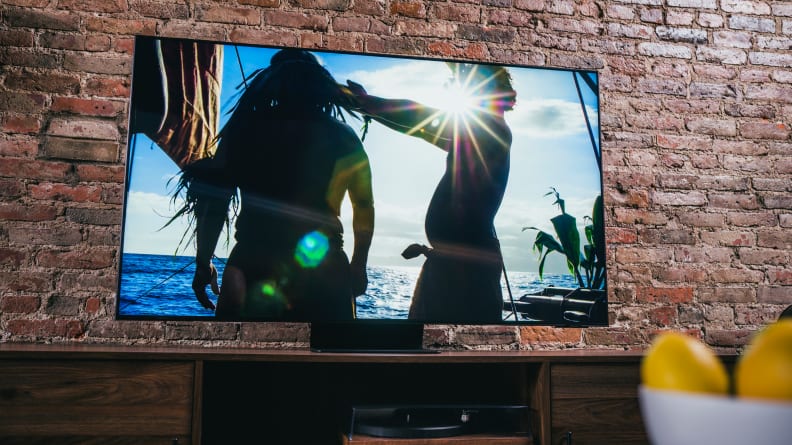
Testing revealed excellent contrast production in both SDR and HDR modes—brightness is one of this TV's strongest performance points.
In our recent reviews of some very premium 2021 OLED TVs from Sony and LG, we praised those sets for their excellent contrast, despite lamenting that they still weren’t as bright (in general) as many high-end LED TVs. Well, the QN90A is one of those TVs, and incredible brightness is one of its key attributes.
For non-HDR content, the QN90A averages around 300 nits of brightness, which is an ample amount when you consider that it does so while producing a black level around 0.01 nits. The average VA-equipped LCD TV with an LED backlight usually manages 0.05 nits during this test, which is multiple magnitudes brighter than the QN90A’s black level.
This stable display of contrast is most certainly the handiwork of the QN90A’s mini-LED backlight, its biggest upgrade for 2021. And things get even better when you’re watching in HDR: we measured brightness numbers well above 1,000 nits and peaking around 1,500 (though in other picture modes besides “Movie” you may get closer to 2,000); that peak is twice the brightness of those more expensive OLEDs. And while the QN90A naturally doesn’t match OLED black levels, it still remains respectably inky even when it’s doing its best to rival the star at the center of our solar system.

The QN90A's searing mini-LEDs and quantum dot color combine to create truly beautiful scenes.
In terms of real-world experience, this means you’re getting a laudably bright HDR TV that looks luminous in either standard or HDR playback, but without sacrificing the highly valuable black levels that make contrasting elements really pop.
Like any non-OLED TV, these numbers tend to always be in flux: when most of the screen is dark, the QN90A’s micro-LED dimming sometimes dips as low as 0.002 nits, which is practically OLED territory. When most of the screen is very bright in HDR, our testing showed that you may get black levels as high as 0.1 nits. This might be distracting on a dimmer TV, but next to 1,000+ nits of brightness it’s much less noticeable.
These fluctuations in brightness and shadow quality from scene to scene are handled by the QN90A’s backlight dimming algorithm, which really takes advantage of the micro-LEDs. There are tighter contrast and dimming zones overall, and smaller clusters of LEDs can illuminate independently of those around them thanks to the smaller LED size. This pushes the QN90A’s contrast composition closer to that of an OLED model, though naturally it can’t quite achieve total parity.
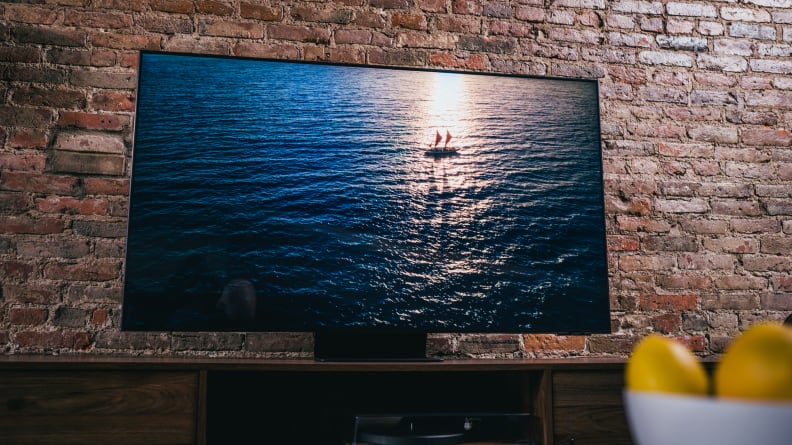
The mini-LED dimming algorithm ranges between OLED-like darkness and huge bursts of light, though most content is somewhere in between.
The end result is a TV with some seriously fine performance. The huge brightness here does occasionally exhibit some bloom in tricky scenes (excess backlight is visible around bright objects through shadowy areas of the screen), but in general, it’s handled much better than previous QLED models that lacked the mini-LED backlight. The high brightness numbers also make for much better off-angle horizontal viewing than average LEDs, making it more enjoyable to watch the QN90A from around the room.
From searing brightness to respectably inky shadows and tightly controlled dimming functions, the QN90A is a terrific choice for a huge range of content types, including TV, movies, and video games. You won’t get that painted-on OLED look here, but you also won’t have to close all the blinds if you want to watch on a sunny day.
Smooth motion for sports and games
Naturally, this high-end Samsung TV delivers a 120Hz refresh rate—the better of the two refresh rate flavors (60 and 120) that TV panels deliver. While this gives it an inherent advantage in terms of fast-paced content like sports and games, it also means it handles Blu-rays and film content that play back at 24 frames per second without judder (which cannot be said of TVs with 60Hz panels). But that’s just the tip of the iceberg.
Samsung hasn’t just designed a 120Hz panel and left you to your own devices here. The QN90A is also equipped with a number of software elements meant to help simplify and correct for the most common motion-related issues that still crop up for many TVs. The “Motion Xcelerator Turbo+” settings may sound a little silly, but they’re the latest version of Samsung’s MEMC (motion estimation/motion compensation) suite previously called Auto Motion Plus.
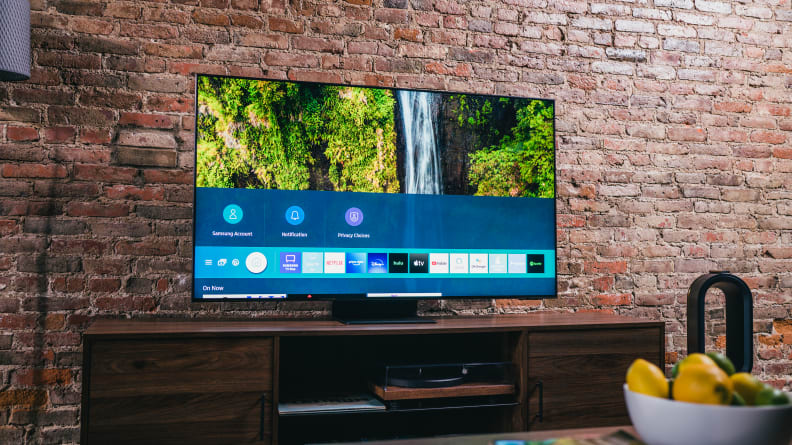
The QN90A's 120Hz refresh rate, suite of motion settings, and Game Bar make it a great choice for content like sports and video games.
Like previous Samsung TVs, you’re getting a range of motion presets as well as the ability to manually set the TV’s de-blur and de-judder efforts. Across the range of possibilities, this can be set up to achieve various levels of smoothing-related realism across content like sports or nature documentaries. This requires some tweaking if you want absolute perfection across all video, but for the average viewer it takes a lot of the work out of getting motion settings right.
Samsung has gaming in its sights this year as well, and in some very specific ways. The primary nod toward gaming comes in the form of Game Bar, a menu that appears in a strip (or bar) along the bottom of the screen to give you easy access to gaming-specific features. This is where you’ll find menus and toggles for things like VRR (variable refresh rate), giving you a glimpse of where something like FreeSync is toggleable; connected devices like headsets; input lag; the frames per second your device is playing in; and whether HDR is enabled.
Another big focus of the Game Bar menu is Super UltraWide Game View (the PR jargon is real on this TV), which adjusts the letterbox size to allow games to display in both 21:9 and 32:9 aspect ratios. It's one of the first times this kind of setting has been available on a TV, which is pretty cool.
With all these features in tow and especially because of the QN90A’s HDMI 2.1 compatible inputs, this TV is especially well-suited for next-gen HDR gaming on a PlayStation 5 or Xbox Series X.
Quantum dot color still sizzles
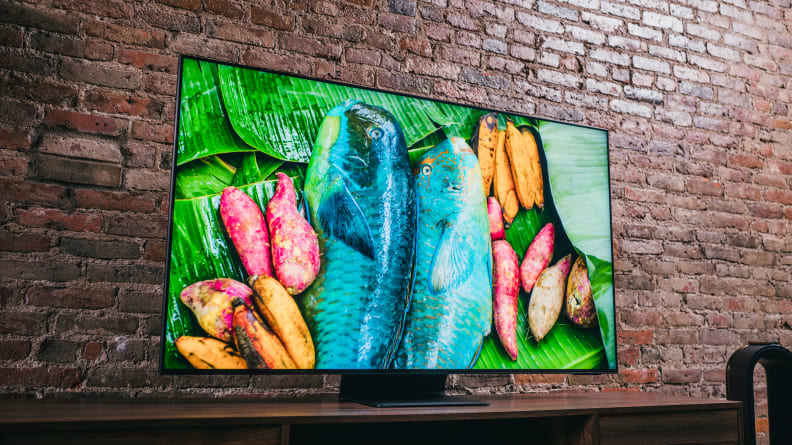
The QN90A boasts a huge range of color gradation and color saturation, making content really pop.
One of the first major upgrades that helped set Samsung's "QLED" TVs apart from the average LED/LCD model was the addition of quantum dots, which greatly enhance red and green primary color saturation using blue-tinted light from the LED backlight. Because TVs use what's called additive color, red, green, and blue make up all the other colors on the screen.
The result is a huge jump in color saturation: the QN90A hits almost 100% of the DCI-P3 (HDR) color space, just like this year's top OLED models. This brings terrific quality to almost anything you watch or play: fire looks more red-orange, jungles look more verdant and realistic, sunsets are a revelation. For LCD TVs, hitting these super-saturated colors requires a lot of brightness, and the QN90A has the goods.
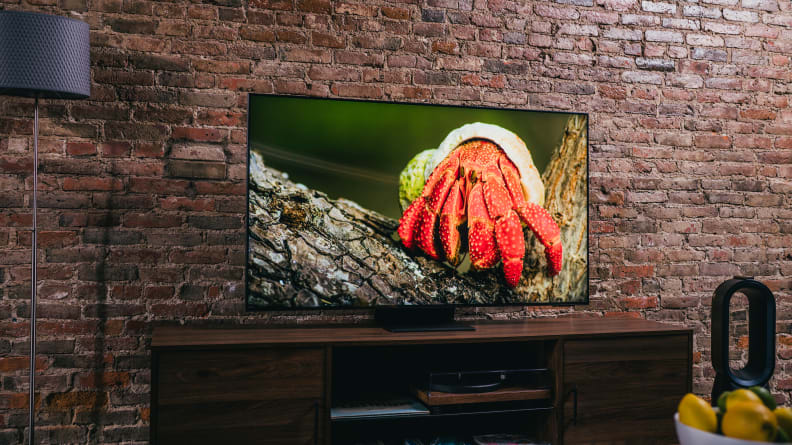
Quantum dots bring a searing amount of color to reds, pinks, greens, cyans, and so on—the color saturation here is a key reason to buy this TV.
While previous QLED TVs had quantum dots, Samsung's Neo QLED models are the company's first time combining the radical quantum film with tiny backlight diodes. While this doesn't specifically impact the saturation of colors, it does help to localize pixel-to-pixel production of different shades and gradations over smaller zones, making for an increased amount of realism.
Something about the color we noticed is that to really pop the quantum dots, the backlight is quite blue. This means everything looks very "cool" in the "Vivid" picture mode, and sometimes the color temperature of low-lit scenes looks bluer than it should. Low-light color control is difficult for all TVs, and we measured some wildly high color temps around 10 IRE (the first analog step above 0, or black). In real-world terms this can make for some color inaccuracy during very dark scenes, but it's not something we noticed often at all.
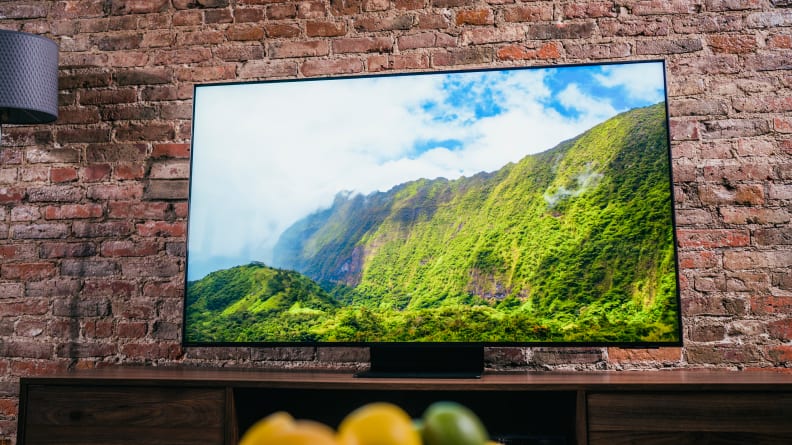
While QLED TVs have always had quantum dots, Neo QLED models have tighter dimming zone and LED control, making for greater realism via granulation abilities.
For the vast majority of content, you can expect brilliantly saturated and accurate colors, including those tricky areas like skin tones and subtle, lower-light scenes. While the QN90A isn't more colorful than a premium OLED, it's just about as colorful, and can maintain that brilliant "pop" look even in a room with lights on. For some viewers, that ability to survive ambient lighting makes a big difference, but only you know your viewing environment.
As usual, Samsung hasn’t skimped on design
Some of the best features about Samsung’s QN90A include its stellar brightness and wealth of software customization features, but it’s also worth mentioning what an all-around attractive TV this is.
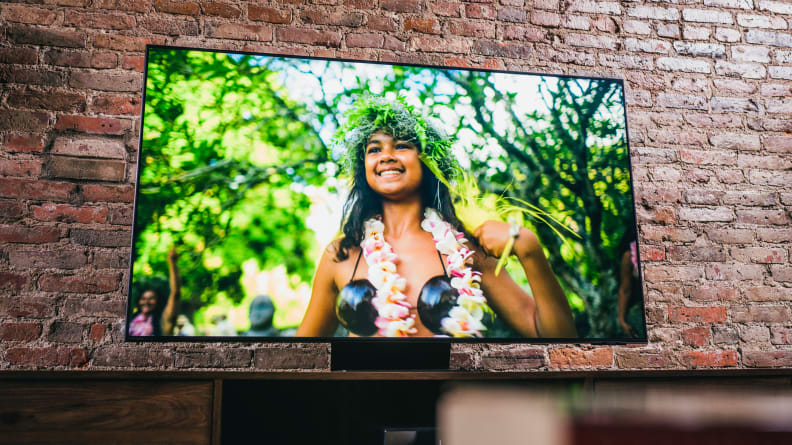
Wrapped in thin gunmetal bezels and perching atop an equally handsome stand, the QN90A is a good-looking TV, no?
We were expecting a very slim side profile thanks to the TV’s mini-LED backlight (they’re 1/40th the size of reg’lar size diodes, apparently), and that’s just what you’re getting here. The thin bezels and gently curved rear chassis atop a substantial but equally slim tabletop stand make for one truly handsome TV. I particularly like that Samsung has opted for a more unique stand design than the usual “two feet set out to the sides” that every TV seems to use right now.
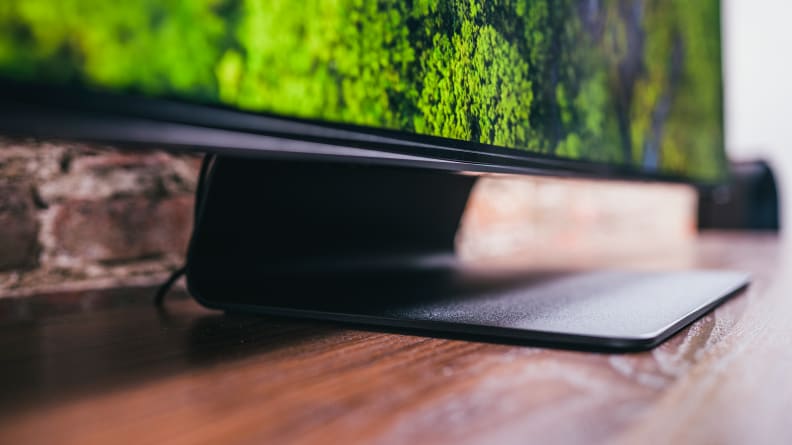
Samsung has moved away from end-mounted feet and opted for a minimalist tabletop stand that curves out from beneath the TV. We dig it.
The remote has been redesigned, too: the QN90A includes Samsung’s new, eco-friendly Solar Cell remote. While it looks a lot like Samsung’s remotes from previous years, this one is completely different in that it doesn’t include any batteries: it charges by indoor or outdoor light, and can also be charged over USB.
While we were a bit worried about how well the remote would handle sitting in our light-controlled (very dark) testing lab, it had plenty of juice, and worked as efficiently as Samsung’s other remotes. As long as it’s in a room with somewhat regular light you shouldn’t need to worry about the battery just dying on you, but you can always charge it up manually if need be. It's a win, both in terms of utility and ecological benefit.

This year, the Neo QLED TVs come with Solar Cell remotes which charge off of indoor or outdoor light. Ours functioned great even after spending time in our darkened lab environment.
All in all, the QN90A is a handsome TV, and feels sturdy despite how slim and sleek it is. You’re getting plenty of connectivity options (see the Connectivity section for details), and the Solar Cell remote is a great, eco-friendly addition to the package.
Zippy processing, solid features
The QN90A TVs utilize a new processor called Neo Quantum Processor 4K, and let me tell you, Mr. Anderson, it powers a lot here. The Tizen smart platform is as snappy as ever, and jumping around the TV’s apps and software menus is a fluid experience.
That’s saying a lot considering all the various functions the processor is handling. Beyond VRR (variable refresh rate) and ALLM (auto low latency mode) processing, the QN90A TVs also do some really cool extra things like Multi View (allowing you to view multiple sources at the same time) and Tap View, Samsung’s version of NFC (tap your phone to the TV to transfer what you’re watching to the big screen). Fitness fans will also be glad to hear that Samsung Health is included by default, allowing you to plan and execute workouts at home.
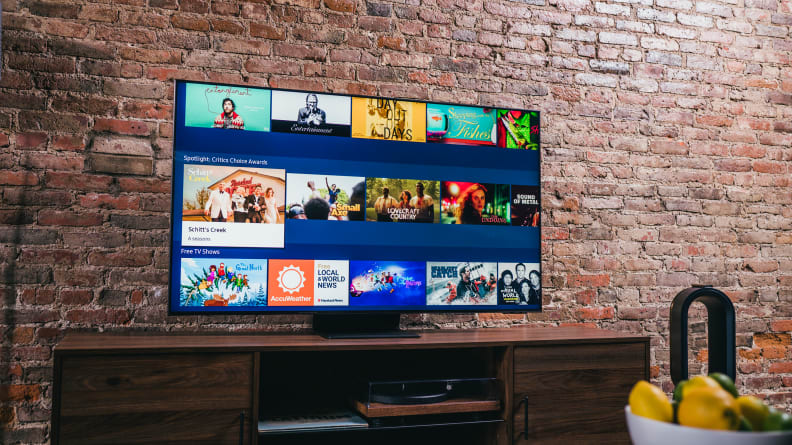
The QN90A comes equipped with the snappy Tizen smart platform and a huge range of features for customizing your experience.
If you’re planning to pair a soundbar with this TV (and you probably should), there are ample audio processing functions to dive into, as well. The SpaceFit Sound function helps the TV tailor sound to your specific living room space, while Active Voice Amplifier helps to boost dialogue in movies and TV shows (a common pain point for at-home audio). And if you’ve got a newer Q-Symphony Samsung soundbar in particular, Samsung’s Q-Symphony mode allows the QN90A to intelligently utilize both the bar and its own onboard speakers to deliver a more robust virtual-surround experience.
While it doesn't decode Dolby Atmos directly, it can pass it to an external device (like a soundbar or receiver in a multi-speaker setup) over both Dolby Digital Plus directly from onboard apps, or from a Blu-ray player in high-resolution via eARC. However, the TV does not support Dolby Vision, which is a sham because it's an excellent, premium version of HDR video. That said, the QN90A does cover a lot of ground with its bright, vivid HDR10 and HDR10+ performance.
What we don’t like
Dimming could be a bit better
For how bright it is, the QN90A’s biggest performance hurdle comes in the form of bloom (excess light around bright objects in a dark space) and flashlighting (visible light from the edges of the screen, such as during 16:9 letterboxed content).
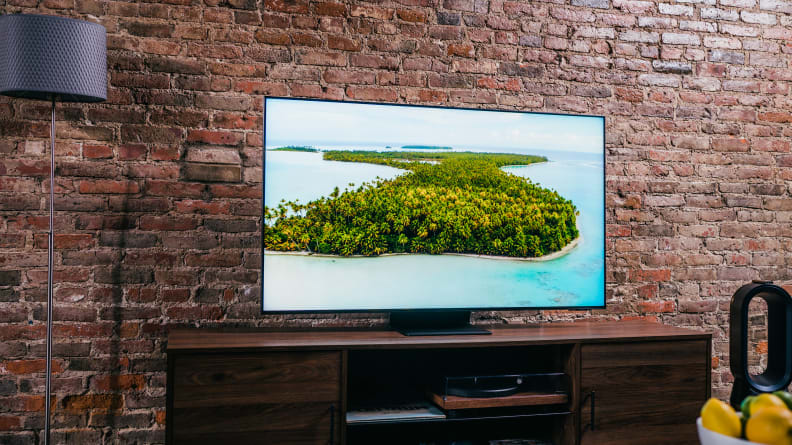
During difficult scenes where bright objects were closely contrasted with shadowy content, we noticed occasional LED blooming.
While the mini-LED backlight does a lot to tune the local dimming in a way that mostly avoids these problems, it doesn’t entirely solve them. During test patterns with very bright HDR spots on black backgrounds, bloom was clearly visible at times. While these test patterns aren’t always indicative of what real content will look like, AV enthusiasts will likely notice elements of bloom while watching this TV.
Should You Buy It?
Yes—especially if you want amazing HDR
The QN90A’s mini-LED backlight gives it a huge advantage compared to past LED/LCD TVs: contrast. Getting inky black levels alongside searing brightness is this TV’s claim to fame, and it really dishes things out where impressive HDR is concerned. As usual, you're also getting oodles of color thanks to the quantum dot tech. All the software extras and its premium design feel like icing on the cake: this picture quality is awesome, closing the gap with premium OLED TVs.
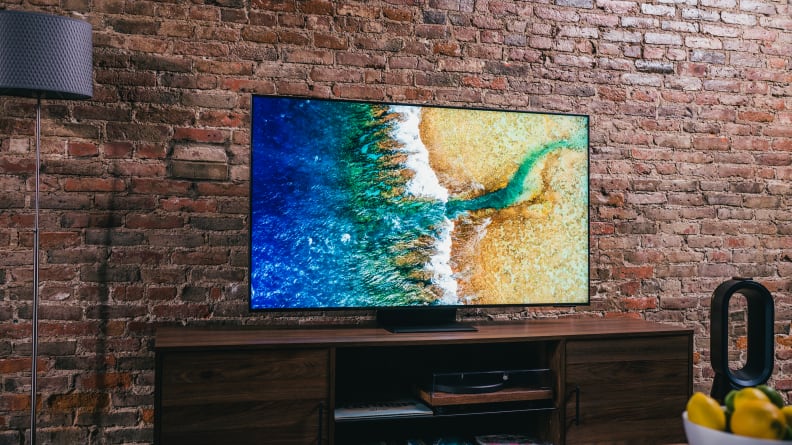
The QN90A's excellent contrast and super-saturated colors put it almost toe to toe with the year's best OLED TVs.
This TV is so good, I don't even want to say "buy it if you don't want to pay for an OLED." If you like to watch with lights on or in a bright room and you want top-tier picture quality, this is the TV to buy, period. It's expensive, but cheaper than the flagship OLEDs, and it'll class up your living room with its smooth design details and eco-friendly remote. Cinephiles who might begrudge the occasional LED bloom should probably go for an OLED—LG's G1 or C1 come to mind—but everyone else will love this TV.
It's also worth noting that we expect the price to drop considerably later this year. This is an established pattern with Samsung, and I'll eat my hat if it hasn't gotten a bit more affordable by fall 2021. There are more affordable mini-LED/quantum dot-equipped TVs out there—TCL's 6 Series comes to mind—but they lack the QN90A's corner-to-corner polish. If you want the best of Samsung's 4K TVs for 2021, this is the way.
Meet the testers
Lee was Reviewed's point person for most television and home theater products from 2012 until early 2022. Lee received Level II certification in TV calibration from the Imaging Science Foundation in 2013. As Editor of the Home Theater vertical, Lee oversaw reviews of TVs, monitors, soundbars, and Bluetooth speakers. He also reviewed headphones, and has a background in music performance.
Julia is the Senior Scientist at Reviewed, which means that she oversees (and continually updates) the testing of products in Reviewed's core categories such as televisions, washing machines, refrigerators, and more. She also determines the testing methods and standards for Reviewed's "The Best Right Now" articles.
Checking our work.
Our team is here to help you buy the best stuff and love what you own. Our writers, editors, and experts obsess over the products we cover to make sure you're confident and satisfied. Have a different opinion about something we recommend? Email us and we'll compare notes.
Shoot us an email





